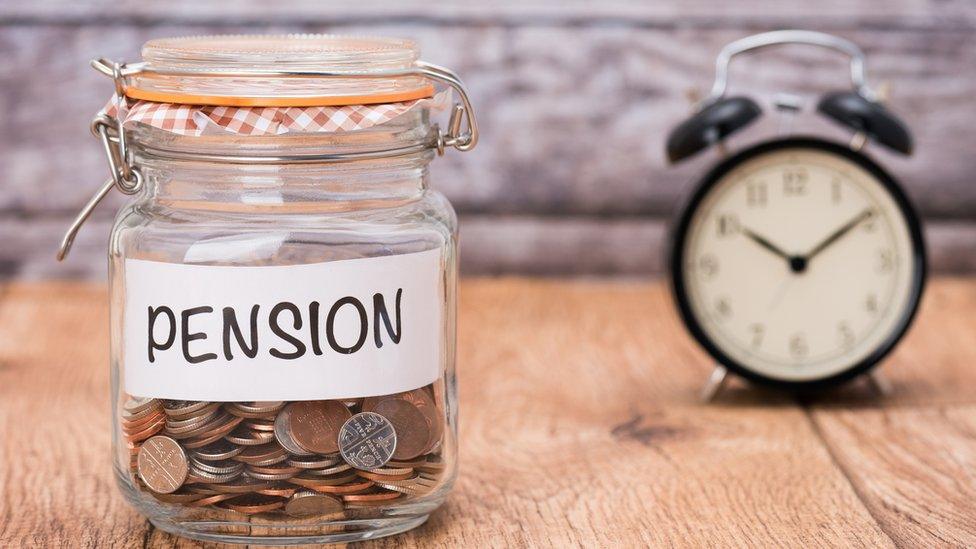Pensions: Automatic saving to start at 18 under new plans
- Published

Waiters are among the workers who have been enrolled in recent years
Every worker aged 18 or over will begin saving into a workplace pension unless they opt out, under government plans to extend its automatic enrolment scheme.
At present, the scheme means employers must enrol staff aged 22 and over and earning above £10,000 into a pension.
Ministers hope to reduce the minimum age to 18 in the mid 2020s, and say it will affect about 900,000 young people.
The system has been credited with ensuring more prepare for older age, but it means extra costs for employers.
It has been introduced gradually since October 2012.
'Habit of saving'
Work and Pensions Secretary David Gauke told the BBC's Andrew Marr Show there had been "greater saving for pensions" since automatic enrolment came into effect.
"We want to extent that to young people under 22.
"I think we will get more people into the habit of saving."
He admitted increases in contributions from next year "might put people off", but added "the evidence is that opt-out rates have been lower than people predicted".
Olly Browning, 21, welcomed the encouragement to save, adding that pensions had "not really crossed my mind yet".
He told the BBC: "I think especially in London, [I have] moved jobs quite frequently, tend not to stay in one place too long, so pensions have always sort of been lower down the list of things I've been conscious of."
However, one industry figure was unimpressed by aspects of the Department of Work and Pensions' wider pensions review.
Ex-pensions minister Steve Webb, director of policy at pensions firm Royal London, said: "There are some great ideas in this review, including starting pension saving at age 18 and making sure that every pound that you earn is pensionable.
"But the proposed pace of change is shockingly lethargic.
"Talking about having reforms in place by the mid 2020s risks leaving a whole generation of workers behind."

What is automatic enrolment?
Unless they are already signed up to a workplace pension, a slice of a worker's pay packet is automatically diverted to a pension savings pot, which is invested until retirement.
Their employer also makes a contribution, as does the government.
Individuals have the option to opt out if they wish to, although that will mean losing the employers' contribution.
Anyone on a short-term contract, working where an agency pays their wages, or who is on maternity, adoption or carer's leave should still be eligible.
The total minimum contribution is currently set at 2% of earnings (0.8% from the worker, 1% from an employer, and 0.2% as tax relief from the government).
From April 2018, it will increase to 5% of earnings (2.4% from the worker, 2% from the employer, and 0.6% as tax relief).
From April 2019 onwards, it will rise to 8% of earnings (4% from the individual, 3% from the employer, and 1% as tax relief).

The plan to lower the starting age follows a review of the system.
Those earning less than £10,000 can ask their employer to enrol them.
Iona Bain, founder of the Young Money blog, said the move was still inadequate in solving a long-term pension crisis for the young.
She said that school leavers, facing a "storm of financial pressures", should have the same National Living Wage as those aged 25 and over, if they were expected to contribute into a pension.


The move will require legislation, as will the proposed other changes to the system including:
Contributions calculated as a proportion of all earnings up to £45,000 (the threshold of the higher rate of tax) rather than the current system which calculates it as a proportion of earnings between £5,876 and £45,000. This will help those with multiple jobs
Annual reviews of the trigger point for automatic enrolment (at present, when a worker earns £10,000 or more). Contribution levels will also be reviewed
Exploring the use of technology to encourage the UK's 4.8 million self-employed people to save for retirement
The proposals will cost employers an extra £1.4bn a year, and the government an extra £600m in tax relief a year.
"Requiring employers to contribute from the first pound of earnings, will mean that, by 2019, hundreds of thousands of small employers will have to pay up to £180 more per employee each year," said Mike Cherry, national chairman at the Federation of Small Businesses.

More than nine million people in the UK have been automatically enrolled into a pension so far, adding to the 10.8 million already contributing to a workplace pension.
However, the average proportion of earnings put into an investment-based defined contribution pension has fallen from about 9% of earnings before auto-enrolment, to 4% now.
The DWP's review, led by industry representatives, estimated that 12 million people are not saving enough for their retirement, representing 38% of the working age population.

State pension age calculator DWP, external
How much will I get from a State Pension? DWP, external
How much can I earn from a DC pot? Money Advice Service, external
- Published19 July 2017

- Published13 January 2017

- Published23 September 2016
